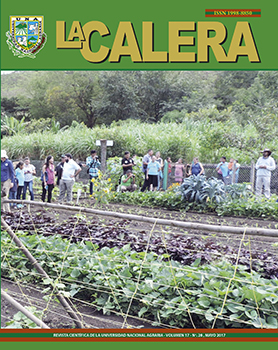Availability of biomass and crude protein contents of Hyparrhenia rufa and Panicum maximum cv Tanzania associated with Leucaena leucocephala and Gliricidia sepium in pasture alley cropping system
DOI:
https://doi.org/10.5377/calera.v17i28.6364Keywords:
Pastures alley, protein crude, biomass disponibility, botanical composition, leguminous treesAbstract
It was evaluated the effect of the partnership of H. rufa and P. maximun cv Tanzania with L. leucocephala and G. sepium in the availability of biomass and crude protein content (PC). The study was carried out in the property Santa María, La Chocolata, Rivas. The area was of 2 579.2 m2 divided into two plots with: three double rows of black and two G. sepium of L. leucocephala, with a distance of 7 m between alley, furrow between 1 m and 0.5 m between plants . The evaluation was carried out between 2009 and 2010 with seven cycles of grazing and frequency of 48 to 53 days of rest. The availability and botanical composition was made with the technique of double-sampling BOTANAL a day before grazing. Defined scales from 1 to 5 based on the percentage of cover, height, relationship stem-leaf (grass); cup diameter, height and number of sprouts (legume). The grass is short to 20 cm and 80 cm the legumes. For the dry matter is took a sample of 200 g and are dry for 72 h at 60 °C. It is performed an ANOVA for repeated measures and a linear regression. It was found that H. rufa is higher on tillering with 95.4 surpassing by more than 11% to Tanzania, however this last exceeded in diameter of tillers in over 16% to H. rufa. Tanzania contains 24% more than biomes that H. rufa and with the contribution of biomass of the legume is difference is 22.2%. L. leucocephala exceeds 90 % and 22% in availability of biomass to G. sepium in both pastures. In the contents of PC, Tanzania is above than 34% and 2.3 % in the edible and non-edible part respectively. Similarly L. leucocephala overcame 13 and 18% to G. sepium in two pastures.
Downloads
1509

